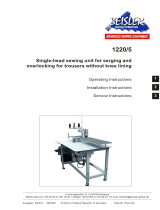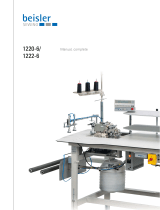Page is loading ...

Contents Page:
Part 2: Installation Instructions for the 743-121
1. Delivery Scope for the Sewing Unit
. . . . . . . . . . . . . . . . . . . . . . . . . . . . . . . . 3
2. Installing the Sewing Unit
2.1 Transporting the Sewing Unit . . . . . . . . . . . . . . . . . . . . . . . . . . . . . . . . . . . . . 3
2.2 Setting the Work Height . . . . . . . . . . . . . . . . . . . . . . . . . . . . . . . . . . . . . . . . 4
2.3 Fastening the Thread Stand . . . . . . . . . . . . . . . . . . . . . . . . . . . . . . . . . . . . . . 4
2.4 Checking the V-belt Tension . . . . . . . . . . . . . . . . . . . . . . . . . . . . . . . . . . . . . . 4
3. Electrical Connection
3.1 Connecting the Microcontrol unit . . . . . . . . . . . . . . . . . . . . . . . . . . . . . . . . . . . 5
3.2 Checking the Nominal Voltage . . . . . . . . . . . . . . . . . . . . . . . . . . . . . . . . . . . . 5
3.3 Setting the Motor Protection Switch . . . . . . . . . . . . . . . . . . . . . . . . . . . . . . . . . 6
3.4 Checking the Direction of Motor Rotation . . . . . . . . . . . . . . . . . . . . . . . . . . . . . . 6
3.5 Checking Positioning . . . . . . . . . . . . . . . . . . . . . . . . . . . . . . . . . . . . . . . . . 6
4. Pneumatic Connection
. . . . . . . . . . . . . . . . . . . . . . . . . . . . . . . . . . . . . . . . 7
Home

2

1. Delivery Scope for the Sewing Unit
–
Basic equipment, depending on execution with bundle clamp and
remover device.
–
Microcontrol.
–
Thread stand.
–
Small parts with the accessories.
2. Installing the Sewing Unit
CAUTION !
The sewing unit may only be installed by trained personnel.
Before installation the following transport securing devices are to be
removed:
–
The securing band from the sewing drive.
–
The angles which hold the frame feet to the wooden pallet.
–
The screw clamps on the transport carriage.
2.1 Transporting the Sewing Unit
The sewing unit has 4 castors for moving it in-house.
CAUTION !
When the sewing unit is in operation the castors must be screwed in so
far that the unit stands firmly on its feet.
–
For transport turn the set screws 1 - 4 to the left.
The feet must have sufficient floor clearance for transport.
–
Move the sewing unit.
–
To lower the sewing unit turn the set screws 1 - 4 to the right.
The feet must stand firmly on the floor.
1
2
3
4
3

2.2 Setting the Work Height
The work height is adjustable between 84.5 cm and 124.5 cm.
The sewing unit is set at its lowest height for shipping.
Setting the work height
–
Loosen the fastening screws 1 - 4.
–
Set the unit horizontally to the desired height.
–
Securely tighten the fastening screws 1 - 4.
2.3 Fastening the Thread Stand
The assembly and position of the thread stand can be seen in the
photo on the title page.
–
Insert the stands and tighten the nuts under the work plate.
–
The thread spool holders and take-off arms must lie above each
other.
2.4 Checking the V-belt Tension
It should be possible to press the V-belt together about 10 mm at its
center.
Setting the V-belt tension
–
Swing the drive until the desired V-belt tension is reached.
1
2
3
4
4

3. Elektrical Connection
CAUTION !
All work on the sewing unit’s electrical components must only be
conducted by electricians or appropriately trained persons.
The mains plug must be dis-connected.
3.1 Connecting the Microcontrol
–
Place the control unit on the mounting plate
(snap-on mounting).
–
Connect the cables:
Caution!
Carefully insert the plugs into the control unit back plate.
In as far as possible match the designations on the cables to those
on the back plate.
Also observe the differing equipment of the plugs with pins and
slots as well as their number and arrangement.
–
Screw the plugs tight.
3.2 Checking the Nominal Voltage
The nominal voltage given on the identification plate and the mains
voltage must match !
For conversion to a different mains voltage the appropriate parts kit
must be installed.
The parts kit consists of:
Belt pulley, V-belt, Protection switch.
Nominal Voltage: Order No.:
3 ~ 380 - 400 V + N , 50 Hz 743 000524
3 ~ 220 - 230 V , 50 Hz 743 000574
3 ~ 220 - 230 V , 60 Hz 743 000644
The wiring must be altered for conversion to other mains voltages. The
wiring is shown in the circuit diagram.
Appropriate to the mains voltage the bridges in the motor terminal box
are to be switched
" Star "
or
" Delta "
!
1
5

3.3 Setting the Motor Protection Switch
The motor protection switch must be set appropriately to the mains
voltage.
220 - 230 V 4,2 A
380 - 400 V 2,5 A
3.4 Checking the Direction of Motor Rotation
CAUTION !
Before commissioning the sewing unit it is essential that the direction
of the motor rotation be checked.
Switching on the sewing unit with the wrong rotation direction can
cause damage to the unit.
–
The correct handwheel rotation direction is shown by an arrow on
the handwheel belt protection.
–
If the rotation direction is
not
correct, then it must be checked if
the power supply produces a clockwise rotary field.
Should this be the case then 2 phases in the connection plug must
be interchanged.
3.5 Checking Positioning
The sewing unit should position when the take-up lever is in its upper
dead point.
Checking positioning
–
Switch off the sewing unit.
–
By turning the handwheel bring the take-up lever to a middle
position.
–
Switch on the sewing unit.
The sewing unit positions.
Setting the position
–
Loosen the threaded pins of the position transmitter.
–
Hold the position transmitter collar 1 in place.
–
By turning the handwheel set the take-up lever at the upper dead
point.
–
Check the positioning again.
1
6

4. Pneumatic Connection
CAUTION !
For a flawless functioning of the pneumatic control procedures the
following points must be observed.
The compressed air supply is to be such that the minimum operating
pressure does not fall below
5 bar
, even at the moment of greatest air
consumption.
Connection to the compressed air supply occurs through accessories
available as optional equipment ( 797 003031 ) or with
customer-supplied connection materials.
Operating pressure 2 = 6 bar
The blower pressure 1 must be adjusted to the material.
Standard setting: approx. 3 bar
To set the pressure lift the appropriate knob and turn.
Turn to the left = Decrease pressure
Turn to the right = Increase pressure
1
2
7
/











